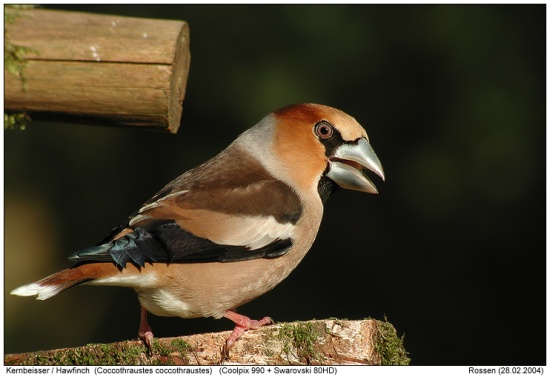- Coccothraustes coccothraustes
Identification
16-18cm
- Chestnut-brown
- Grey hind collar
- Orangey-buff crown and cheeks
- Black eye patch
- Black throat
- Large white wing patch
- Black wing tips
- Very heavy stout bill (bluish-grey in summer; yellow in winter)
- Broad white tip on tail
- Flesh-coloured legs
Distribution
Widely distributed but generally uncommon.
Breeds in southern Scotland and England and from the Pyrenees and western France to Denmark, southern Sweden and the Baltic States east to Russia and the Urals. In the south breeds in southern Iberia and North-West Africa in Morocco, north-east Algeria and north Tunisia. Also Corsica, Sardinia, and Italy, the Balkans, Greece and northern Turkey. Also breeds in the Crimea and Caucasus.
Also found in Asia from Kazakhstan, through western Afghanistan, Japan to China.
Northern and eastern populations are migratory leaving breeding areas in September-October, returning late March-early May. Elsewhere in range mainly resident or short-distance dispersal only. Winter range more widespread in western and southern Europe especially around the Mediterranean and a scarce winter visitor to the Balearics, Malta and Sicily, Crete and Cyprus and also in the Near East including Lebanon and Israel.
'Vagrants recorded in Iceland, the Channel Islands, Madeira, Canary Islands and Gibraltar.
Taxonomy
Subspecies[1]
- C. c. coccothraustes:
- C. c. buvryi: smaller bill, greyer crown and rump and less white on wings and tail
- C. c.nigricans: darker-backed
- C. c. humii:
- Eastern Kazakhstan to Kyrgystan, Tajikistan and western Afghanistan
- C. c. japonicus:
- Sakhalin, Hokkaido and northern Honshu; winters to eastern China and Bonin Island
Habitat
Usually occurs in mature deciduous or mixed woodland, often beech and hornbeam, up to 3000m. Also found in some areas in parks, large gardens and orchards. In winter may be seen in more open habitats, along hedgerows and woodland edges.
Behaviour
Often flocks after breeding.
Vocalisation
<flashmp3>Coccothraustes coccothraustes (song).mp3</flashmp3>
Listen in an external program
References
- Clements, JF. 2008. The Clements Checklist of Birds of the World. 6th ed., with updates to December 2008. Ithaca: Cornell Univ. Press. ISBN 978-0801445019.
- Birdwatchers Pocket Guide ISBN 1-85732-804-3
- Collins Pocket Guide to British Birds 1966
Recommended Citation
- BirdForum Opus contributors. (2024) Hawfinch. In: BirdForum, the forum for wild birds and birding. Retrieved 8 May 2024 from https://www.birdforum.net/opus/Hawfinch




